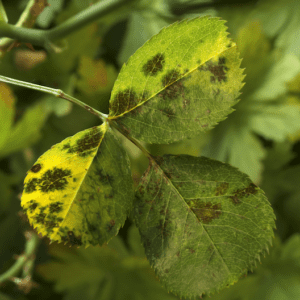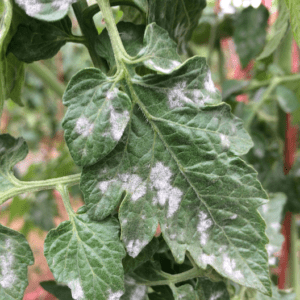As gardeners of all skill levels tend to their flowers, plants, shrubs, and other foliage, it’s all too easy to overlook a leaf here or there that is discolored and write it off as an area to prune. Maybe it’s from bugs, or maybe it’s from lack of water. However, many home gardeners are not familiar with the signs of common plant diseases. If left untreated, it’s possible for the disease to spread and infect nearby plants. By administering proper medication, you can stave off disease and help your plants rebound to their healthy state. Be on the lookout for these irregularities on your plants and in your gardens, and you’ll be sure to have a healthy crop of blooms and flowers all year long!
Common Plant Diseases
Black Spots on Roses
While we all love to admire the fragrant blooms of rose bushes, it’s important to regularly check the lower leaves of rose bushes. Black spot, one of the most common diseases that affects rose bushes, can wreak havoc on a rose garden. A fungus, black spot begins to show itself by appearing as, you guessed it, black spots on the top side of leaves. As the disease worsens, leaves will begin to yellow and fall off. Wet, humid climates with warmer than normal temperatures are the prime environment for black spot to take hold of rose bushes. If left untreated, the fungus can even survive the winter, leaving you with bare rose bushes next spring.

At the first sign of black spot, immediately prune off the infected leaves. Most garden centers will carry an anti-fungal spray that can be used on the lower leaves of the rose bush that will stop the spread of black spot. Be sure NOT to add the infected leaves to your compost pile, as black spot fungus can survive in the soil and eventually effect other plants when you reuse the soil in your garden.
Mosaic Virus
The mosaic virus is so commonly seen in cucumber and tomato crops, that each respective vegetable actually has it’s own dedicated strain of the disease. Mosaic virus isn’t just limited to infecting tomatoes and cucumbers though, it can actually affect over 150 different types of vegetables, fruits, and flowers, including commonly grown crops like squash and cauliflower. The virus itself is most commonly spread by aphids and is often difficult to diagnose the cause because the symptoms can vary from plant to plant. Things to look out for are blister-like spots on leaves, stunted growth, and deformities and discoloration in leaf growth.
The best way to avoid encountering mosaic virus in your vegetable garden is to select strains of plants that are resistant. This is not a foolproof method but will give the best chance at having a healthy harvest that isn’t affected by mosaic virus. Another tip to keep mosaic virus at bay is to take steps to control aphids and leafhoppers in your garden. Try covering your tomatoes, cucumbers, squash, etc. with a floating row cover to keep aphids away.
Downy Mildew
Another plant disease that requires careful inspection of lower leaves of your plants, downy mildew begins to show itself on the topside of leaves as yellowish-white patches of color on older growth. Upon more careful inspection of the underside of these leaves, you may find a cotton-colored fungi. In growing zones that experience very high humidity and cooler temperatures, downy mildew can become a problem that infects multiple plants throughout your garden.
If you suspect plants in your garden are infected with downy mildew, remove and destroy those plants and soon as possible. This type of bacteria can survive winters on plant debris and in soil, so removing any signs of it from your garden right away is the best way to keep it from spreading. For plants that may be growing alongside an infected plant, introduce a copper spray. Begin using the copper spray about 2 weeks before long periods of wet weather and repeat the treatment every week until all signs of downy mildew are gone.

Spider Mites
While not an actual bacterial disease like the previously mentioned issues, spider mites can wipe out an entire plant in a matter of days if they go unnoticed. While many think spider mites are insects, they are actually a type of arachnid. Spider mites tend to affect plants grown in hot, dry conditions, and will thrive in gardens with heavy insecticide use, since their natural predators will have been killed or repelled by its use. Host plants for these unwelcome garden visitors include plants like eggplant, strawberries, beans, melons, ornamental flowers, and most types of houseplants. You’ll be able to spot a spider mite infestation by noticing browned, curling leaves, and a type of webbing that looks spider-like.
To stop spider mites in their tracks, immediately prune away sections of plants that are infested, and discard in the trash. Visit your local garden center or nursery, where you’ll have a wide variety of insecticide treatments at your disposal. For an organic approach, apply neem oil or horticultural oil to all parts of the plants, in an attempt to kill eggs that may be laid throughout the leaves. If your local garden center sells ladybugs, they make an ideal (and easy) solution to slowing the spider mites from spreading. Plus, you’ll have happy ladybugs, as they make their way around your garden and eat up the spider mites.
These are just a few of the dozens upon dozens of types of diseases that home gardeners may face by growing a variety of plants. Whether you only grow vegetables, focus on flowers, or have a wide variety of greenery throughout your property, it’s always important to be on the lookout for signs of disease. By taking action at the first sign of a disease in a plant, you can be saving your entire crop, a large bed of blooming flowers, or expensive shrubbery.
Have you had to battle it out with a plant disease before? We’d love to hear your story! Share with us in the comments section below!